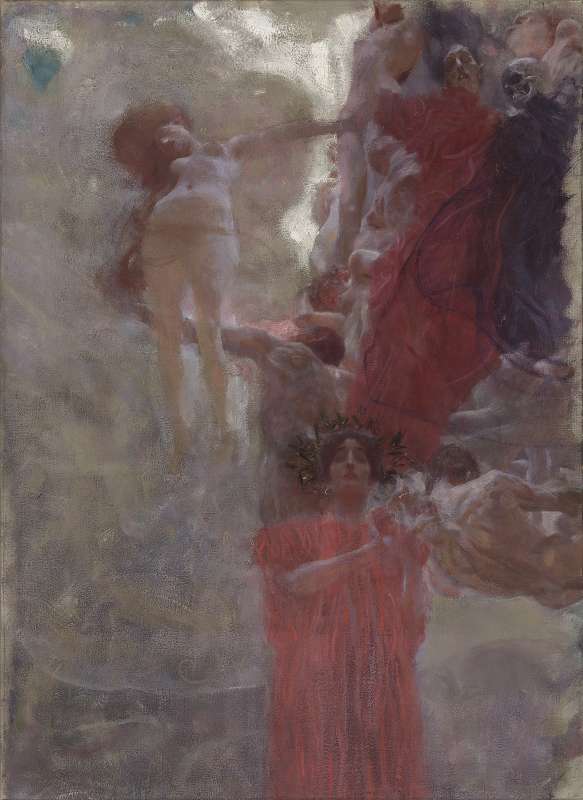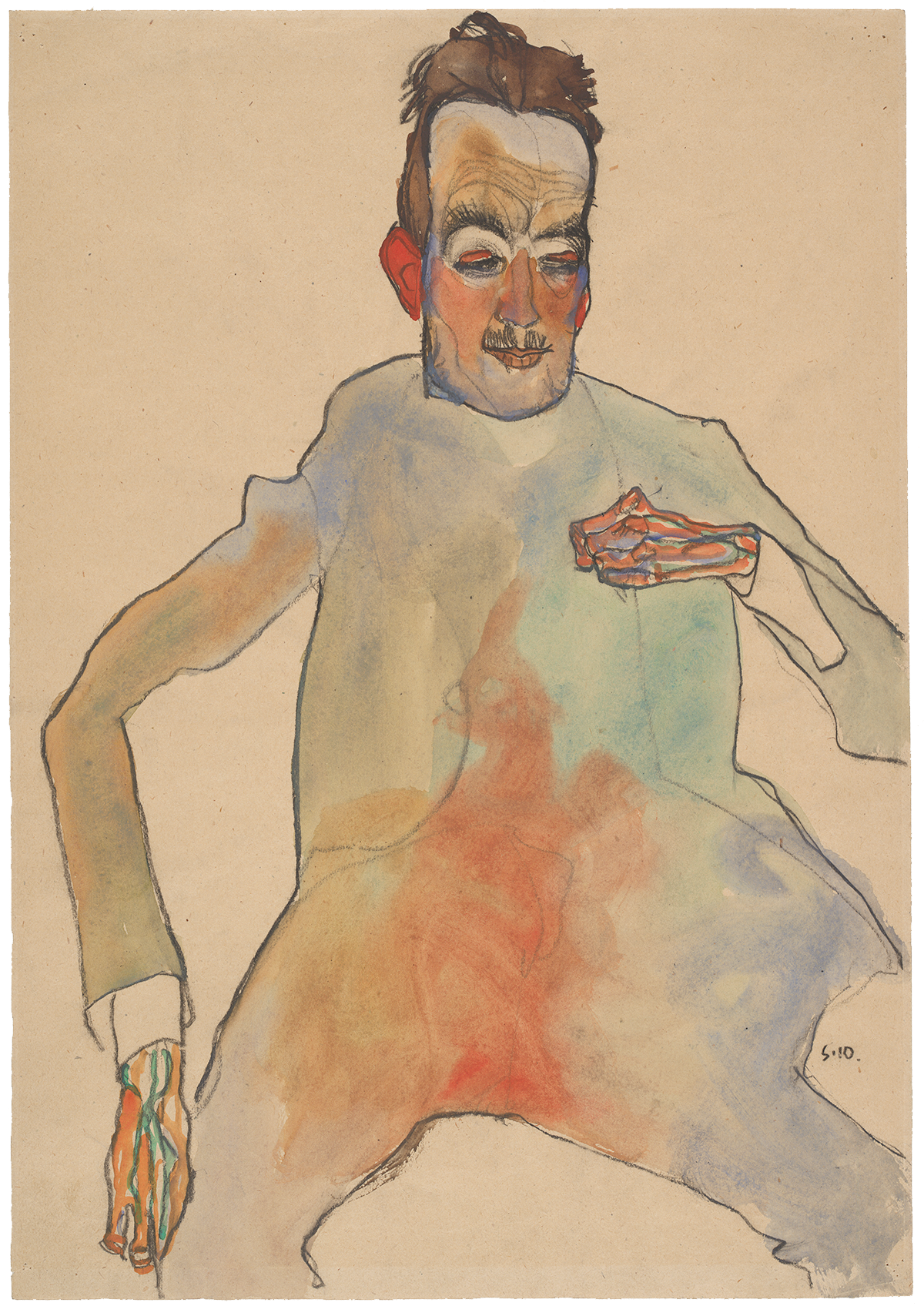February 25 through May 28, 2018
Marking the centenary of the deaths of Gustav Klimt (1862–1918) and Egon Schiele (1890–1918), the Museum of Fine Arts, Boston (MFA), presents a special exhibition of drawings on loan from the Albertina Museum in Vienna. Klimt and Schiele: Drawn, on view from February 25 through May 28, 2018 in the Lois B. and Michael K. Torf Gallery, examines the separate, yet parallel experiences of the acclaimed Austrian modernists, as well as the compelling ways in which their work relates—particularly in their provocative depictions of the human body.
Organized thematically, the selection of 60 works on paper extends from the artists’ early draftsmanship to explore how each shifted away from traditional training to more incisive and unconventional explorations of humanity over the course of their careers. The MFA is one of three museums—and the only U.S. venue—hosting exhibitions of the Albertina’s rarely loaned drawings by Klimt and Schiele in 2018, joining the Pushkin Museum of Fine Arts, Moscow, and Royal Academy of Arts, London, to mark the 100th anniversary of the artists’ deaths.
Klimt and Schiele: Drawn is accompanied by an illustrated volume, Klimt and Schiele: Drawings, produced by MFA Publications.

The 60 important drawings exquisitely reproduced in this large-format volume reach from each artist’s early academic studies to more incisive and unconventional explorations of nature, psychology, sexuality and spirituality. Striking and provocative even today, these works led both artists into controversy (and even a brief imprisonment for Schiele) during their creators’ lifetimes.

Klimt advised, “Whoever wants to know something about me as an artist ought to look carefully at my pictures and try to recognize in them what I am and what I want.” This album of unforgettable drawings from the collection of the Albertina Museum, Vienna, provides a direct connection to the minds of two master draftsmen exploring the limits of representation, as well as the shock of recognition at seeing our own inner selves caught on paper.
About the Author
Katie Hanson is Assistant Curator, Paintings, Art of Europe, at the Museum of Fine Arts, Boston.
“Part of the satisfaction of being with Klimt’s and Schiele’s drawings is that they get under your skin—they’re hard to forget once you’ve seen them,” said Katie Hanson, Assistant Curator, Paintings, Art of Europe. “You feel the presence of these artists through the freshness and immediacy of their draftsmanship, the energy of which is still palpable even after a hundred years.”
Nearly 30 years apart in age, Klimt and Schiele shared a mutual respect and admiration for each other’s talent, although the work they produced is decidedly different in appearance and effect. Klimt’s drawings are often delicate, while Schiele’s are regularly bold. Klimt often used his as preparatory designs for paintings, while Schiele considered his own as finished, independent pictures and routinely sold them. Despite these departures, their works are also related. With frank naturalism and unsettling emotion, both Klimt and Schiele challenged conventions and expectations in portraits, nudes and allegories.
Beginnings
The exhibition opens with early works that exemplify the artistic training completed by both Klimt and Schiele. After a two-year introductory course at Vienna’s Kunstgewerbeschule (School of Applied Arts), which he began at age 14, Klimt received a scholarship to continue at the Fachschule für Zeichnen und Malerei (Technical School for Drawing and Painting), where he remained until 1883. This training led him to important commissions to decorate buildings around Vienna.

Three studies for the ceiling decoration Shakespeare’s Theater in the Burgtheater (1886–87) demonstrate Klimt’s deft handling of the differentiation of textures—the softness of hair, the firmness of flesh over bone and the stiffness or rumpled ease of fabric. Meanwhile, Schiele’s precocious talent made him the youngest member of his class at the Akademie der Bildenden Künste (Academy of Fine Arts) when he began his coursework in 1906, at age 16.

In Portrait of a Bearded Man (1907), the teenaged artist gave discrete attention to the flowing beard, slightly bristlier mustache and carefully combed hair. These examples of their early draftsmanship showcase the beautiful shading and modeling that are hallmarks of academic training.
Inner Life Made Visible
Soon enough, both artists shifted away from academically grounded works. Their drawings began to describe a sense of tension or energy in addition to visible features. Their treatments of the human body became less conventional and less conservative, permitting them to examine the inner workings and urges of humanity.
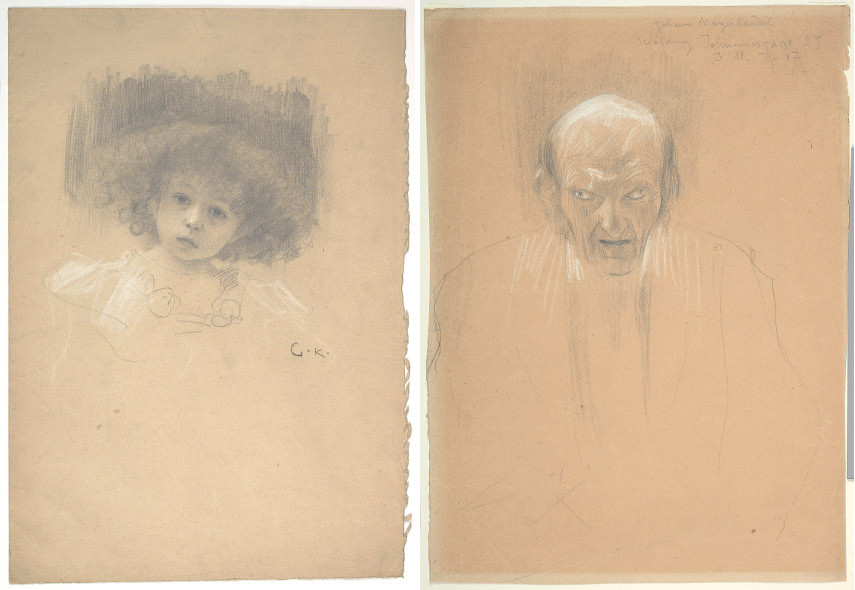
Klimt’s Portrait of a Bald Old Man (Study for Love) (1895) (above right) is unsettling—the white illuminates the elderly man’s head and provides an eerie glow to his unfocused eyes, contributing to the haunting impression of the figure. This drawing and Portrait of a Child (Study for Love) (1895), (above left) depicting a little girl, served as studies for an allegorical painting on the theme of love—now in the collection of the Wien Museum in Vienna—in which Klimt explores the duration and range of experiences a lasting love might include.
Klimt provided something of an example to Schiele, who saw the older artist defying conventions. While Klimt was not interested in self-portraits, preferring above all to paint women, Schiele saw all bodies, including his own, as subject to appraisal.
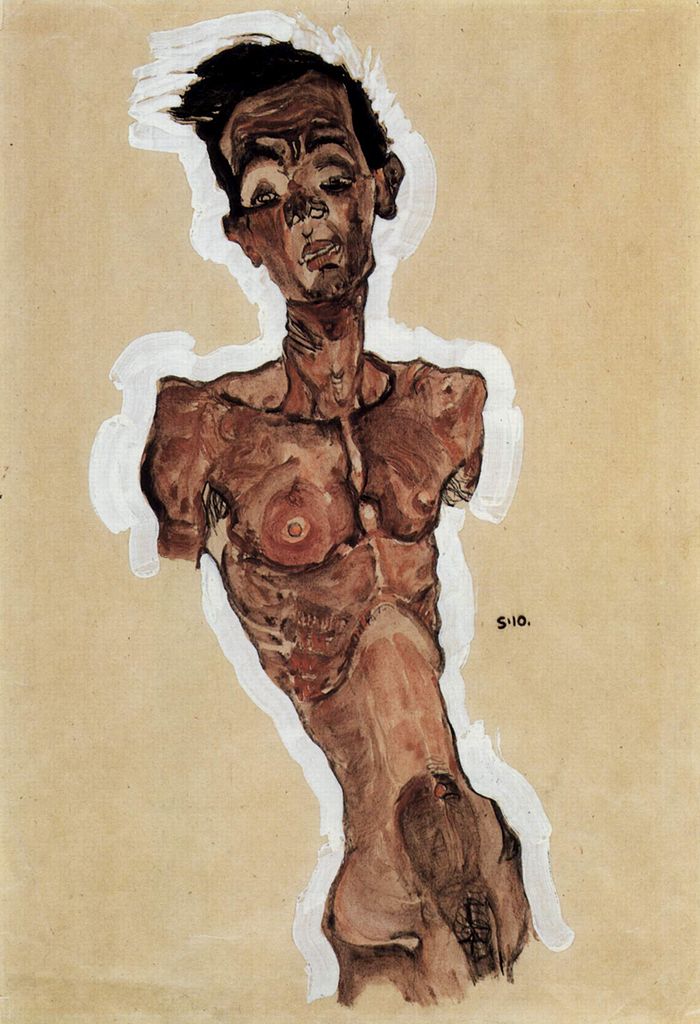
His convulsive self-portraits, such as Nude Self-Portrait (1910), show a young man grappling with himself. The drawing bristles with energy, depicting his dark hair standing on end as if electrified. With one eye open and the other closed, full pouty lips and furrowed brow, the facial expression is dramatic but illegible. The skin is tinged purple and blue, covering an emaciated body—far thinner than Schiele’s actual physique—that juts at a dramatic angle into the sheet. It is surrounded by a thick white band that evokes the inner glow—the radiant energy of living beings that so fascinated Schiele.
Schiele also applied this approach to portrayals of local working-class children. Six of these drawings are displayed in the exhibition, including
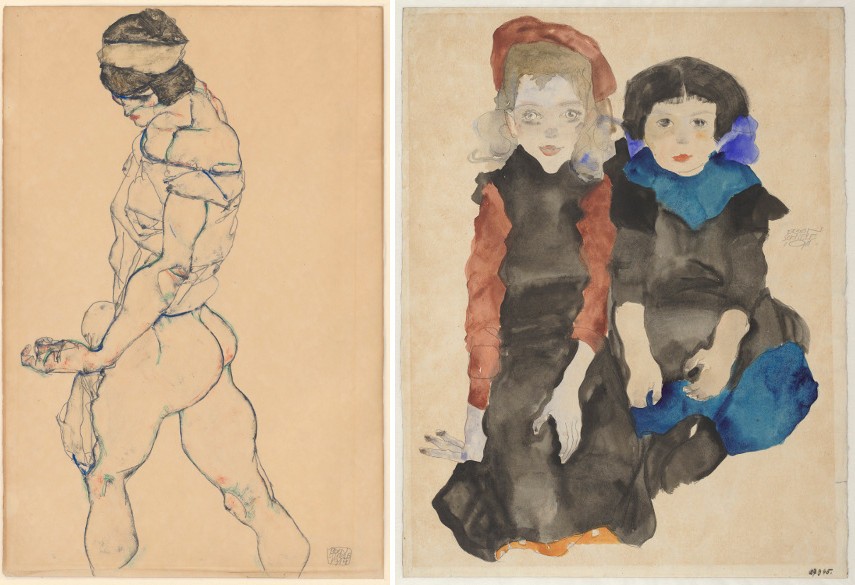
Two Crouching Girls (1911), in which the subjects appear at first glance to perch like dolls propped into position. On closer inspection, however, the unnatural, unhealthy color of the flesh—particularly in the icy tone of the blonde girl’s skin—and the outsized hands contradict the initial charm and make them more unsettling.
Nudes
Klimt and Schiele’s shared interests in human experience and inner urges are perhaps most evident in their depictions of nudes. Despite the twinge of voyeuristic unease that they may stir, the compositions are hard to look away from. The bodies are unidealized, making them seem all the more real, and often it is hard to tell what they are doing at first glance. Without the aid of a title, it takes persistent effort to identify what is depicted in

Klimt’s Reclining Woman, Seen from Behind (1916–17)
and, even helped by the title, the looping lines by the figure’s face in

Reclining Half Nude with Arms Entwined behind Her Head (1916–17) do not readily coalesce into something recognizable. Both women lounge seemingly in midair, unmoored from furnishings.
Schiele, too, experimented with such unexpected omissions—The Pacer (1914) (above), for example, looks down at her tensely curled hand as if it holds something, but there is nothing there.
The Stuff of Scandal
Despite their successes and supporters, Klimt and Schiele were no strangers to controversy. Klimt’s innovative approach to embodying ideas caused a scandal when he was asked to create large-scale works. In 1894, he and his early collaborator Franz Matsch were selected to design ceiling paintings for the University of Vienna. Klimt showed his works, depicting philosophy, medicine and jurisprudence, in process in 1900, 1901 and 1903 with the Vienna Secession, a group of artists who broke away from the state-sponsored academy to exhibit independently. Although the paintings were lost in a fire during World War II, related drawings such as
Two Floating Studies (for Medicine) (1897–98)

Two Studies of a Skeleton (Studies for the Transfer Sketch for Medicine) (about 1900), Gustav Klimt. Courtesy of Albertina, Vienna and Museum of Fine Arts, Boston
and Two Studies of a Skeleton (Studies for the Transfer Sketch for Medicine) (about 1900) convey the immediacy and unexpected naturalism that some of Klimt’s contemporaries found so shocking.

Another firestorm of controversy broke out over Klimt’s Beethoven Frieze, part of the Secession’s 1902 exhibition, which celebrated the composer.

Standing Female Nude (Study for the Beethoven Frieze: “The Three Gorgons”) (1901), Gustav Klimt. Courtesy of Albertina, Vienna and Museum of Fine Arts, Boston
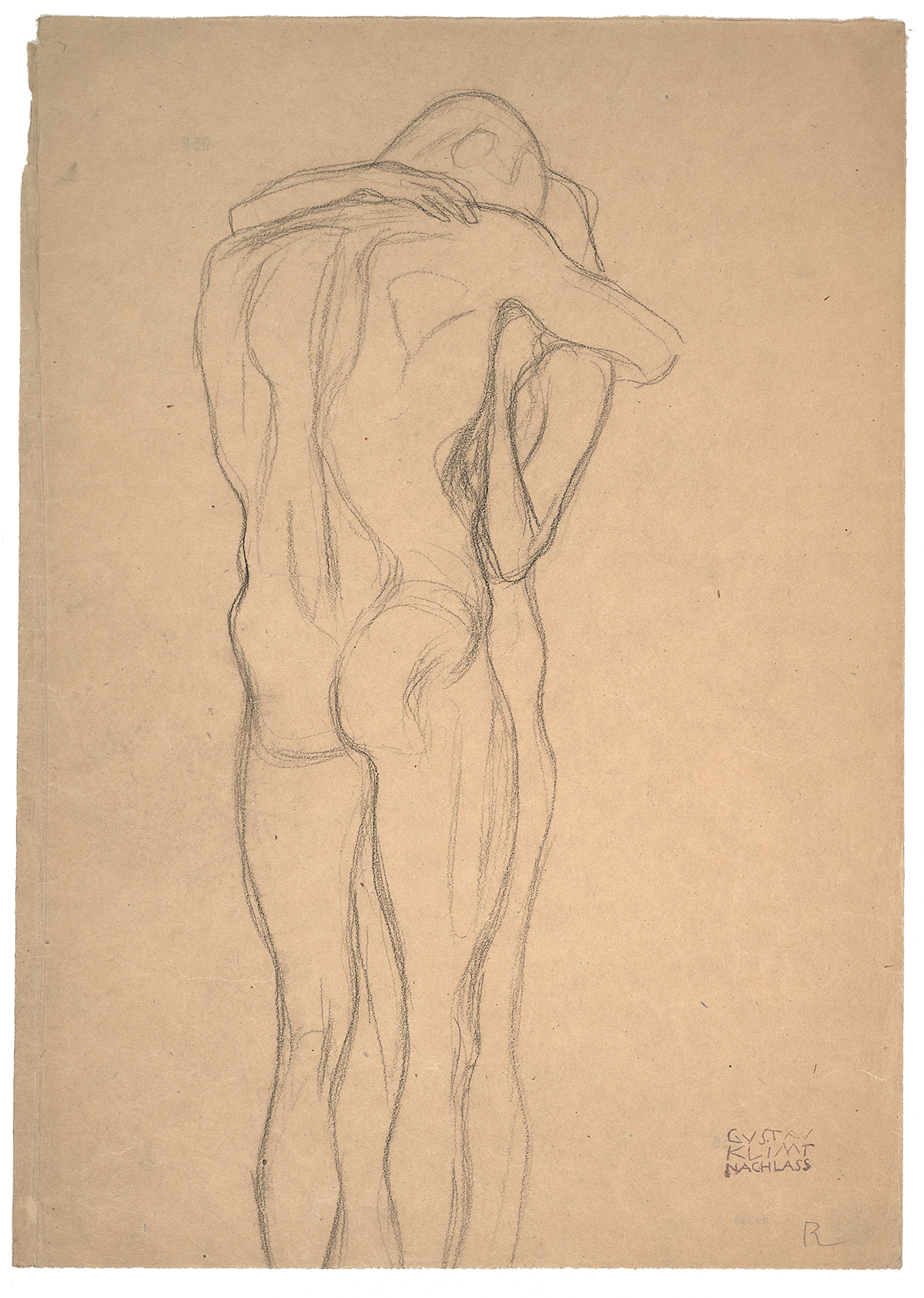
Gustav Klimt, Embracing Couple, 1901.(Study for ‘This Kiss to the Entire World; Beethoven Frieze’).Black chalk. 45 x 30.8 cm. The Albertina Museum, Vienna.
The frankly depicted, unidealized nude bodies that embody unseemly feelings such as sexual desire earned the artist accusations of pornographic obscenity.
Schiele, too, made art and lived a life that flouted polite expectations. In 1912, a local adolescent who wished to run away from home sought help from the artist and his girlfriend. Although the child returned home unharmed, her parents accused Schiele of kidnapping, rape and immorality—charges that could have meant up to 20 years in prison. The artist was arrested on April 13 and a trial was held on April 30. The first two charges were ultimately dropped as unfounded, but the third held, as the police investigation turned up drawings in Schiele’s studio that were deemed indecent for minors to see. The artist spent just over three weeks in jail, before and after his court appearance, and three drawings made during this time in prison—dated April 19, 23 and 24—are on view in the exhibition. Combining poetic and dramatic titles with bold compositions, these drawings record Schiele’s mounting despair.
Great article about the above,with the images.
Plants and Places
Schiele found evocative, emotional resonances all around him—not only in the bodies and faces of people, but also in nature. Two drawings by the artist

—Red Chrysanthemum (1910)

and Yellow Chrysanthemum (1910)—show flowers of the same species in two stages. The robust red example, colored with broad strokes, opens to its maximum fullness, while the frail yellow flower comes undone, with drooping leaves and the spindly petals of a blossom past its prime. The same autumnal melancholy also pervades Schiele’s depiction of

Old Houses in Český Krumlov (1914), Egon Schiele. Courtesy of Albertina, Vienna and Museum of Fine Arts, Boston
Old Houses in Český Krumlov (1914) in the Czech Republic—the birthplace of his mother and where the artist lived briefly in the summer of 1911, while seeking distance from city life in Vienna.
Portraits
Portraiture provided both Klimt and Schiele with a way to make money and connections—as well as a meeting place for their artistic visions and the individual character of their sitters. Klimt maintained a lucrative portrait practice among avant-garde patrons and collectors in and around Vienna.
Two studies for

a portrait of his supporter Eugenia Primavesi (1912 and 1913) show little detail in the figure’s face, yet convey a strong sense of her character. Her raised chin, seen in both drawings, confirms her commanding presence.
Also on view are two studies for a painting of Primavesi’s daughter Mäda (1912–13)—

Klimt’s only commissioned portrait of a child, now in the collection of the Metropolitan Museum of Art. Additionally, three studies for a portrait of Amalie Zuckerkandl—one of his last paintings, left unfinished—provide a glimpse into the artist’s process. The sitter’s garment seems to writhe with energy in each drawing, while her pose and demeanor shift as Klimt searches for the definitive portrayal.
Klimt came to Schiele’s aid following his imprisonment in 1912, which left the younger artist devastated and financially ruined. An introduction to Klimt’s patrons August and Serena Lederer led to Schiele’s friendship with their son Erich, who would become one of the leading collectors of his work.
The artist’s portrayal of the teenaged Eric Lederer with Red Collar (1913), seated in a jaunty pose, suggests the awkwardness of his youth. Additional portrait drawings by Schiele on view depict others close to the artist, including

his mother Edith
The Artist’s Mother, Sleeping (1911), Egon Schiele. Courtesy of Albertina, Vienna and Museum of Fine Arts, Boston

Portrait of the Artist’s Sister-in-law Adele Harms (1917), Egon Schiele. Courtesy of Albertina, Vienna and Museum of Fine Arts, Boston
The skin of both women is rendered with blotchy discoloration—it appears flushed, bruised and even seemingly decaying. Often seen in his self-portraits, the effect makes the drawings more complicated to look at and the reactions they induce more visceral.

Egon Schiele,
Seated Female Nude, Elbows Resting on Right Knee (detail),
1914.
Pencil, gouache on Japan paper. 48 x 32 cm. The Albertina Museum, Vienna.


Albertina Museum, Vienna
Another excellent review
